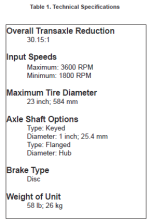totallymopar
Member
- Joined
- Sep 24, 2023
- Threads
- 3
- Messages
- 20
I have an early 90's(I believe) Huskee Lawn tractor,fairly rugged construction,20HP Twin cyl.engine(industrial/commercial) HUGE rear tires(on 13" rims!).It has a hydrostatic variable speed tranny,also rather large,1-1/2" axles 4-bolt rim mount, with cooling fins on it.Is there any way to identify who made the tranny,and where to find it? Also,I want to use it as a runner,when I'm not mowing with it.Top speed now is just under 10 MPH.I would like it to go 20,or a bit faster,but don't want to grenade the rear end.The rear axle pulley (3-1/4") is splined,and I plan to leave that alone.There is room to put a larger one on the front--I was thinking about 5"" up from the 3-1/2 on it now.With the stock pulleys,and the engine at 3600RPM max,the axle pulley is rotating at about 3877 max. RPM. If I change the engine pulley to 5",with engine at 3600RPM max,the tranny pulley will spin at around 5539 max rpm.Will the hydrostatic tranny in this be up to the speed increase? If not,what transmission would be recommended? The tractor is in very good condition,no leaks or wet spots on the transmission case,and runs well.

